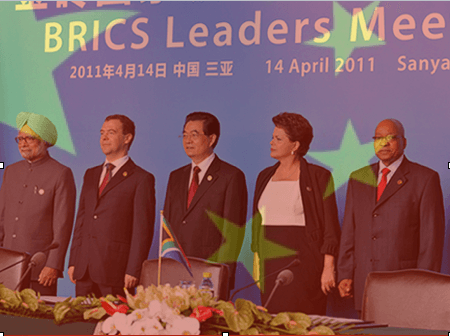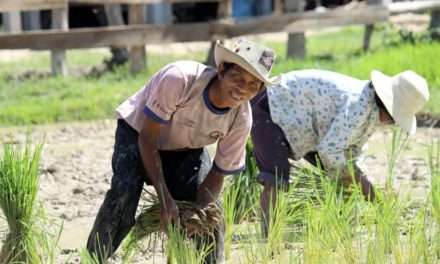By Dorothy-Grace Guerrero
It is commonly said that the world is entering a multipolar phase in global governance with the “rise of the South” or the increasing powers of emerging economies China, India, Brazil, Russia and South Africa (from hereon the BRICS) and the strengthening of their relations as seen in the succeeding BRICS Summit since 2011. By the time this article sees publication, the BRICS Summit in Durban, South Africa would have added new achievements to further that notion. Many believe too that with the economic stagnation in the Eurozone and the US, BRICS countries are gaining more wealth, expertise, consumption power and the political clout to influence and re-arrange the global system to their advantage. The lingering economic crisis in the US is also seen as a signal of the beginning of the end of US hegemony and that among the new powers, many think that China is the most likely challenger to US dominance[1].
Will the North allow the BRICS to take the lead in global governance? Can China and the other new actors present a new and better leadership role in the various political arenas and centers of decision-making? More importantly, since China is seen as the top contender to the North among the BRICS, is it offering a better model of partnership with other developing countries or it is turning out to be a “sub-imperialist”[2] power that will continue the same or more intense practices of exploitation and extraction of natural resources from poorer countries to further enrich itself? Social movements and activist academics are increasingly wary that the economic model it is advancing is the same unsustainable and unjust paradigm that facilitates accumulation of wealth by a few while resulting in the dispossession and pauperization of the already marginalized and powerless.
China’s Role in Promoting a Multipolar Order and BRICS
Jiang Zemin officially incorporated the concept of multipolar world (duoji shijie) into Chinese foreign policy at the 14th Congress of the Communist Party of China in 1992 to support China’s stance that a fair, just and peaceful world is only possible through multipolarity. China’s foreign policy since Jiang’s leadership has acknowledged that a singular and unchecked superpower can be very dangerous as exemplified by the US invasion of Iraq without a UN sanction and the US/NATO actions in Kosovo.
The China – Russia Constructive Partnership Agreement of 1994 that was later renamed China – Russia Strategic Agreement in 1996 not only strengthened Chinese-Russian relations, but also their preference to multipolarity as against the unipolar world order that had emerged after the collapse of the bipolar world order. The China – Russia 1997 Joint Statement strongly emphasized that a fair and just society could only be possible in a multipolar world and not in a unipolar one[3]. The Shanghai Cooperation Organization, which the two countries also lead, is another manifestation of interest to advance multipolarity.
BRICS’ precursor was the Russia-India-China group formally initiated by Russia in 2002 to serve as its platform after its former power had been weakened by the collapse of the Soviet Union and the challenges it had faced with its borders. The history of alliances, tensions, rivalry and differences between these three countries are deep but it seems that these challenges are being overcome by the will to strengthen BRICS.
China worked for the inclusion of South Africa in December 2010. South Africa’s involvement worked well in expanding the geographic representation of the group and further strengthened the multipolar and non-Western character of BRICS. China is now the strongest economic power in BRICS and the most influential in its economic and financial agenda.
BRICS leaders are planning to set up a new development bank to mobilize resources for infrastructure and sustainable development projects within BRICS and other developing countries. The BRICS Bank will supplement the existing efforts of multilateral and regional financial institutions for global growth and development. China is expected to press for it to be based in Shanghai and to operate in yuan, the Chinese currency. From the roadshow discussions happening now in preparation to the Durban summit, the BRICS Development Bank will initially be capitalized at $50 billion, with $10 billion from each of the BRICS members.
China’s Rise as Global Power: what does it mean to the rest of the South
Various forecasts predict that China will soon surpass the US as the top global economic power[4]. Whether this will happen as early as 2016[5] as the IMF predicted using purchasing power parity as basis of analysis or by 2020[6] or 2030[7] according to the World Bank, the “guesstimates” agree that it will be earlier than previous assessments.
China’s role in the global political economy entered a new stage in 2005 when it started to become a new exporter of capital. China is currently the largest holder of foreign currency reserves on the planet, 54 percent of its USD 3.2 trillion in foreign reserves are in US dollars[8].
Since the 2008 global financial crisis, China has accounted for more than 35 percent of all global economic growth[9]. For the first time since 2003 China surpassed the US as the world’s largest recipient of global foreign direct investment (FDI) in the first half of 2012. The data from UNCTAD show that US FDI inflows reached $57.4 billion in the first half said year, down from $94.4 billion in 2011 while China attracted $59.1 billion in foreign investment in the first six months, down from $60.9 billion[10]. Although short-lived, as the US regained dominance by end of 2012, this indicates that investors continue to be attracted by China’s huge market.
China is now investing in Central and Eastern Europe. Premier Wen Jiabao’s Europe tour in April 2012 promoted bilateral and economic trade relations between China and Iceland, Sweden, Poland and Germany and was seen in the Chinese and European sides as an indication of China’s willingness to help alleviate the debt crisis in Europe. A $10 billion credit line to support Chinese investments in Central European infrastructure, new technology and renewable energy was set up in April 2012 during China-Central Europe-Poland Economic Forum in Warsaw, attended by leaders of 16 countries in the region who all traveled to the Polish capital to meet with Wen[11].
China’s economic priority is ensuring access to its goods, expanding outward investments, and consolidating its position as a regional and global hub of advanced production networks. For countries in the South, the more important question about China’s challenge to the US and other old powers is whether such rivalry is making other developing countries more prosperous and stable or if it is leading to more desperate “race to the bottom” among the weak.
China’s aggressive FTAs are underpinned by two objectives. The first is to secure long-term energy supplies and establish sources of other natural resources that it needs for its manufacturing exports. The second objective is to expand its market to various regions to enable it to continue its growth. Currently, China has 14 FTA partners comprising 31 economies and regions including the Asia-Pacific region, Latin America, EU, Africa and Oceania[12]. Since 2002 China has signed FTA Agreements with the ASEAN, Chile, Pakistan, New Zealand, Singapore, Peru, Costa Rica as well as Economic Partnership Agreements with Hong Kong, Macau and Taiwan. It is negotiating FTAs with the Gulf Cooperation Council (GCC), Australia, Iceland, Norway, Southern African Customs Union, Japan and South Korea (China-Japan-SK FTA), and Switzerland. It is in the stage of finishing FTA Feasibility Studies with India and South Korea.
Until 1993, China was a net exporter of oil. The need to find a secure supply of energy prompted it to negotiate oil and gas deals with various countries in the Middle East, North Africa, Sub-Saharan Africa, Russia and Eurasia, Southeast Asia, Australia, and the Americas.
China’s export credit and guarantee agencies; particularly China EximBank and Sinosure are now playing a crucial role in fostering the rapid expansion of Chinese trade and overseas investments. The China EximBank, a state bank solely owned by the Chinese government and the country’s official credit agency, is the world’s largest export credit agency. In total, China has extended $12.5 billion more in loans to Sub-Saharan Africa in the past decade than the World Bank; $67.2 billion was also lent to the world’s poorest region between 2001 and 2010 compared with the World Bank’s $54.7 billion[13]. The China Development Bank, the world’s largest development institution in terms of assets, is putting more resources behind the overseas expansion of Chinese enterprises, particularly in natural resource projects.
Contrary to impressions, it is not true that Chinese investment or loans have no strings attached to them. A study on Chinese banks financing in Latin America, showed that Chinese loans have more stringent demands than World Bank loans. In 2010 China Development Bank lent $20billion to Venezuela in exchange for Venezuela’s payment through oil shipments to China. China sent 30 consultants, led by a former vice-governor of CDB, to Venezuela for 18 days with a mission to check how Venezuela will deliver the oil and to make proposals how to reform its economy to ensure that it will get its money back[14]. In Africa, many riots were spurred by the fact that Chinese workers had been brought in by Chinese investors instead of hiring local labor. Cheap Chinese products are also flooding local markets.
The North Still Rules the World
Despite impressive economic figures, it is misleading to think that China’s rise to the top means that China will soon rule the world the way the US has been done. The US is still the world’s largest economy and its military is still the most powerful. However, it is finding it increasingly difficult to assert a hegemonic role the way it used to due to its own crisis, its burgeoning national debt, the impacts of the Iraq and Afghan invasions and ongoing wars, the relatively “reluctant” global role played by President Obama.
The rise of new powers like BRICS does not necessarily mean that they are seeking to assume the former hegemonic role of the US. It is more likely that a multipolar world means that a new mix of leading countries will define the global political economy together with the US. At this point too, the emerging economies are still playing supporting role to the US and the West. The old powers are still maintaining the lead in many political arena and spaces of decision-making like in the UN, the World Bank and International Monetary Bank (despite latest attempt to put a non-American in the WB in 2012), and in trade and investments[15].
China is also grappling with huge internal problems. Chinese leaders are constantly preoccupied with the task of finding the best formula to address the need for stability and reform as the continued success of China’s economic agenda and more importantly the survival of the Party and the current character of the state are at stake. It is also misleading to focus on China’s and India’s soaring GDP considering the huge number of people in both countries that are poor. Another reality is the huge gaps between the old and new powers’ technological know-how, military capability and political influence in international affairs[16].
China achieved what the 200 years of industrial revolution and modernization efforts of the now advanced economies had achieved into three decades of fast-paced experimentation using an unusual mix of communist politics, developmental experiences of other East Asian countries and capitalist economics. The grow-at-all-cost development paradigm that has enabled it to make the giant economic leap has now reached its limits as shown by its increasingly degraded environment, growing inequality and economic imbalance.
Critics of Asia’s development paradigm have long argued that free trade and neo-liberalism have increased inequality and poverty in the region and especially in China and India despite the two countries’ phenomenal growth. China and India ranked 120th and 170th in the global human security index. China’s market socialism in its modern form is a predatory, dysfunctional and grossly inefficient system that is enormously wasteful and unsustainable[17]. China’s model merely reflects 21st century capitalism, which is characterized by high-speed accumulation by the few, dispossession of the majority’s access to resources and marginalization of their voice in the management of resources. Majority of the current analysis about China’s role in the changing global political economy fails to locate China in the context of neo-liberal globalization.
In the context of the ongoing debate about China’s growing environmental footprint in other developing countries, two aspects are seldom discussed: the limits to growth and a planetary transition to low carbon consumption. China’s rise to the top was achieved through importation of natural resources and their re-exportation in the form of value-added inputs of final products for consumption in other countries, mostly in the West. In effect, the emergence of China as the factory of the world is upholding the unsustainable consumption and production patterns in the developed world. There is also the reality of Chinese TNCs joining the game that has given transnational corporations from developed countries unbridled power.
[1]Ikenberry, G. John, “The Rise of China and the Future of the West: Can the Liberal System Survive?”, 87 Foreign Affairs, January/February 2008.
[2]Patrick Bond defined sub-imperialism as deputy-sheriff duty for new powers such as the BRICS countries, while controlling their own angry populaces as well as their hinterlands. The eco-destructive, consumerist-centric, over-financialised, climate-frying maldevelopment model throughout the BRICS works very well for corporate profits, but the model is generating crises for 99% of the people and for the planet. See also Bond’s “Bankrupt Africa: Imperialism, Subimperialism and the Politics of Finance”, Historical Materialism, Volume 12:4, Leiden, 2004, pp.145-172.
[3] Sino-Russian Joint Statement” of November 10, 1997, the “Joint Statement on Sino- Russian Relations at the Turn of the Century” the “Joint Press Communique on Sino-Russian Summit Results” of November 10, 1998, and the “Sino-Russian Treaty on Good-Neighborliness, Friendship, and Cooperation” in 2001
[4]Maddison, Angus, 2006, “Asia in the world economy, 1500‐2030”, Asian Pacific Economic
Literature, 20(2): 1‐37.
[5]Arends, Brett, “IMF bombshell: Age of America nears end, Commentary: China’s economy will surpass the US in 2016”, Marketwatch, The Wall Street Journal, November 20, 2012, http://www.marketwatch.com/story/imf-bombshell-age-of-america-about-to-end-2011-04-25?link=MW_home_latest_news
[6] Shirley, Andrew (ed), The Wealth Report 2012: A Global Perspective on Prime Property and Wealth, Knight Frank Research, 2012 http://www.thewealthreport.net/
[7] BBC News Business, “China to overtake US and dominate business by 2030”, March 24, 2011 http://www.bbc.co.uk/news/business-12848449
[8]Orlik, Tom and Davis, Bob, “Beijing Diversifies Away from the Dollar”, The Wall Street Journal, March 2, 2012
[9]Beams, Nick, “China Slowdown Deepens Global Crisis”, World Socialist Website, August 16, 2012, http://wsws.org/articles/2012/aug2012/pers-a16.shtml
[10] Hannon, Paul and Reddy, Sudeep, “China Edges Out US as Top Foreign Investment Draw Amid World Decline”, The Wall Street Journal, October 23, 2012.
[11]Millner, Caille, “Eyes on the Price: Beijing Sets its Sights on Central Europe”, Der Spiegel, May 18, 2012 http://www.spiegel.de/international/europe/with-10-billion-dollar-credit-line-china-deepens-presence-in-central-europe-a-833811.html#ref=rss
[12] China FTA Network, http://fta.mofcom.gov.cn/topic/engcc.shtml , also www.bilaterals.org
[13] Cohen, Mike “China Exim Lend More to Sub-Saharan Africa than the World Bank – Fitch says”, Bloomberg, December 28, 2011 http://www.bloomberg.com/news/2011-12-28/china-exim-loans-to-sub-sahara-africa-exceed-world-bank-funds-fitch-says.html
[14]Rabinovitch, Simon, “ A New Way of Lending”, Financial Times, September 23, 2012.
[15] Wade, Robert, “The United States and the World, The Art of Power Maintenance: How Western States Keep the Lead in Global Organisations”, Challenge, Vol.56. No. 1, January/February 2013, M.E. Sharpe, Inc., pp.5-39
[16]Ju, Zhongwen, “Moving toward multipolar world”, China Daily, Dec.12, 2010, http://www.chinadaily.com.cn/opinion/2010-08/12/content_11141897.htm
[17] J. Lee, Will China Fail? The Limits and Contradictions of Market Socialism, Center for Independent Studies, 2007










